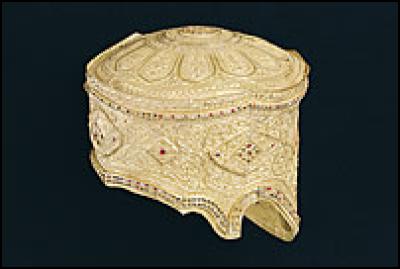The Indiana-Jones-Like Tale Of A Stolen Thai Crown
The Indiana Jones Like Tale Of A Stolen Thai Crown
by Richard S. Ehrlich

Source - Philadelphia Museum Of Art
BANGKOK, Thailand -- A murky tale of thieves, greed and disputed possession of a ruby-and-pearl-studded gold crown, which may have been worn by a Siamese king but now glistens in San Francisco, is a mystery worthy of Indiana Jones.
"A beautiful crown whose place of origin in Thailand has not been conclusively confirmed by exhibition curators and other experts, despite their best efforts" is the "disheartening" focus of a sudden dispute, said a defensive Tim Hallman, spokesman of San Francisco's Asian Art Museum, where the headpiece is currently on display.
"The crown was borrowed from the Philadelphia Museum of Art," Mr. Hallman wrote in a letter to the Bangkok Post after the controversy hit Thai media amid headlines such as: "Headpiece Frenzy."
The 7-1/2-inch tall headpiece resembles a cylinder with a slightly raised, flat top, encircled by elongated arches, and hemmed by an jagged lower border.
The enclosed crown is studded with rubies, pearls and filigree metalwork.
Thai officials admit they cannot yet determine if it is stolen property from the defeated Ayutthaya kingdom of Siam.
During the mid-1400s, when the crown may have been created, Ayutthaya was ruled by King Boromaraja II, who crushed neighboring Angkor Wat's Khmer kingdom, invaded Chiang Mai and seized prisoners, but suffered havoc when spies cut off the tails of the king's military elephants, causing the beasts to rampage, according to historians.
"Among the most intriguing objects in the exhibition are the eight artworks culled from an important cache of Buddha images, votive tablets, ritual objects, and royal jewelry found in the crypt of Wat Ratchaburana, one of Ayutthaya's temples," the San Francisco museum said in an upbeat November press release introducing the exhibits.
"In 1957, thieves broke into the previously unknown crypt deep within its main tower. They found a rich hoard of Buddhist artworks, ceremonial objects, and royal regalia of gold studded with gems," it said.
"We were surprised to see so many golden objects and Buddha statues," said Li, a former thief, who surfaced last week to publicize his role in the caper -- amid hopes that his subsequent bad luck and misery might be lifted by a confession.
"There were swords and crowns. We told ourselves they must have belonged to kings. I got away with some gold ornaments, while my friends took and shared the other items.
"It took about three days to take it all out by putting the items in small sand bags and hauling them up with a pulley," Mr. Li, a Thai, said.
Some of the loot was later rescued, but some was sold through crime syndicates.
"But there's no proof...there was no systematic record of what was there," originally in the looted temple, said Forrest McGill, chief curator of the Asian Art Museum, according to a report on Saturday (March 5) in the San Francisco Chronicle.
"None of us feels comfortable about stolen property. None of us feels comfortable about an archaeological site that's looted before it can be studied. However, the Philadelphia Museum bought the crown fair and square at public auction -- the Sotheby's catalog has a full-page color photograph of the object -- and they've had it on display ever since," Mr. McGill said.
Sotheby's reportedly lists a dealer named Klejman who acquired the crown in 1965.
But Asia abounds with fake antiquities.
Thai officials warned the headpiece might be made of gold and gems, but still be a replica.
Items made in the "Ayutthaya period" were of a "darker gold" and some designs and shapes on the crown were "peculiar," differing from similar headpieces displayed in Thailand's Chao Sam Phraya Museum, they said.
"We could try to buy it back, or seek its return through negotiations. But at this moment, the most important thing is to determine whether the prized headpiece is real or not," Arak Sunghitakul, director-general of Bangkok's Fine Arts Department, was quoted as saying.
As the plot thickens, guilt trips are spreading.
On Tuesday (March 8), the Norton Simon Museum in Pasadena, California, came under Bangkok's scrutiny.
Thailand's National Museum director, Somchai Nakhon Phanom, told the Nation newspaper about a Buddhist amulet and Hindu statue listed in the Pasadena museum's brochure.
"I want the [Thai] government to contact the museum to arrange for them to be inspected," Mr. Somchai said.
"If it is proved that the items are national assets, then the [Pasadena] museum should be asked to return them."
Richard S. Ehrlich, a freelance journalist who has reported news from Asia for the past 26 years, is co-author of the non-fiction book, "HELLO MY BIG BIG HONEY!" -- Love Letters to Bangkok Bar Girls and Their Revealing Interviews. His web page is www.geocities.com/glossograph/


 Binoy Kampmark: Condemning The Right To Self-Defence - Iran’s Retaliation And Israel’s Privilege
Binoy Kampmark: Condemning The Right To Self-Defence - Iran’s Retaliation And Israel’s Privilege Gordon Campbell: On The Making Of King Donald
Gordon Campbell: On The Making Of King Donald Binoy Kampmark: Rogue States And Thought Crimes - Israel Strikes Iran
Binoy Kampmark: Rogue States And Thought Crimes - Israel Strikes Iran Eugene Doyle: The West’s War On Iran
Eugene Doyle: The West’s War On Iran Richard S. Ehrlich: Deadly Border Feud Between Thailand & Cambodia
Richard S. Ehrlich: Deadly Border Feud Between Thailand & Cambodia Gordon Campbell: On Free Speech And Anti-Semitism
Gordon Campbell: On Free Speech And Anti-Semitism